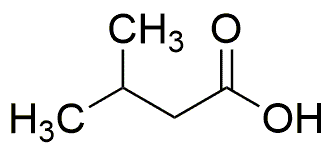Isovaleric acid is widely utilized in research focused on:
- Flavoring and Fragrance Industry: This compound is used as a flavoring agent in food products and beverages, providing a unique, pleasant aroma. Its natural occurrence in certain cheeses enhances the sensory experience of consumers.
- Pharmaceuticals: Isovaleric acid serves as a building block in the synthesis of various pharmaceutical compounds, contributing to the development of medications that target metabolic disorders.
- Agriculture: It is applied in the formulation of pesticides and herbicides, improving their effectiveness. This helps farmers achieve better crop yields while minimizing environmental impact.
- Biotechnology: Researchers use isovaleric acid in fermentation processes, particularly in the production of biofuels and bioplastics, promoting sustainable practices in energy and materials.
- Cosmetics: The compound is incorporated into cosmetic formulations for its skin-conditioning properties, making it a valuable ingredient in lotions and creams.
General Information
Properties
Safety and Regulations
Applications
Isovaleric acid is widely utilized in research focused on:
- Flavoring and Fragrance Industry: This compound is used as a flavoring agent in food products and beverages, providing a unique, pleasant aroma. Its natural occurrence in certain cheeses enhances the sensory experience of consumers.
- Pharmaceuticals: Isovaleric acid serves as a building block in the synthesis of various pharmaceutical compounds, contributing to the development of medications that target metabolic disorders.
- Agriculture: It is applied in the formulation of pesticides and herbicides, improving their effectiveness. This helps farmers achieve better crop yields while minimizing environmental impact.
- Biotechnology: Researchers use isovaleric acid in fermentation processes, particularly in the production of biofuels and bioplastics, promoting sustainable practices in energy and materials.
- Cosmetics: The compound is incorporated into cosmetic formulations for its skin-conditioning properties, making it a valuable ingredient in lotions and creams.
Documents
Safety Data Sheets (SDS)
The SDS provides comprehensive safety information on handling, storage, and disposal of the product.
Product Specification (PS)
The PS provides a comprehensive breakdown of the product’s properties, including chemical composition, physical state, purity, and storage requirements. It also details acceptable quality ranges and the product's intended applications.
Certificates of Analysis (COA)
Search for Certificates of Analysis (COA) by entering the products Lot Number. Lot and Batch Numbers can be found on a product’s label following the words ‘Lot’ or ‘Batch’.
*Catalog Number
*Lot Number
Certificates Of Origin (COO)
This COO confirms the country where the product was manufactured, and also details the materials and components used in it and whether it is derived from natural, synthetic, or other specific sources. This certificate may be required for customs, trade, and regulatory compliance.
*Catalog Number
*Lot Number
Safety Data Sheets (SDS)
The SDS provides comprehensive safety information on handling, storage, and disposal of the product.
DownloadProduct Specification (PS)
The PS provides a comprehensive breakdown of the product’s properties, including chemical composition, physical state, purity, and storage requirements. It also details acceptable quality ranges and the product's intended applications.
DownloadCertificates of Analysis (COA)
Search for Certificates of Analysis (COA) by entering the products Lot Number. Lot and Batch Numbers can be found on a product’s label following the words ‘Lot’ or ‘Batch’.
*Catalog Number
*Lot Number
Certificates Of Origin (COO)
This COO confirms the country where the product was manufactured, and also details the materials and components used in it and whether it is derived from natural, synthetic, or other specific sources. This certificate may be required for customs, trade, and regulatory compliance.


